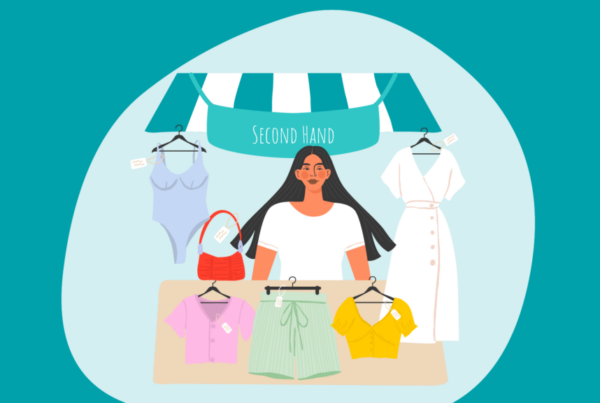In a world increasingly aware of the environmental impact of our consumption choices, it is crucial to closely examine the lifecycle of our clothing. From production to second-hand use, each stage has an impact on the environment. Among the decisions we make when shopping online, choosing the right clothing size may seem insignificant, but it can significantly reduce our carbon footprint. Let’s explore the lifecycle of a garment and the importance of choosing the right size from the start.
Step 1: Manufacturing
Clothing manufacturing is a complex process that consumes significant amounts of natural resources and energy. For cotton clothing production, for example, huge amounts of water are needed to grow cotton. According to Cotton Incorporated, producing one kilogram of cotton can require up to 20,000 liters of water. Additionally, conventional cotton farming often involves the intensive use of pesticides and fertilizers, contributing to water and soil pollution.
For clothing made from synthetic fibers like polyester, nylon, or spandex, the manufacturing process is also energy-intensive and polluting. Producing these materials requires crude oil and other non-renewable resources while emitting greenhouse gases and contributing to air pollution.
Once the materials are obtained, they are processed into fabrics and garments in textile factories. These factories use various processes, including spinning, weaving, knitting, and dyeing. Fabric dyeing, in particular, is a water- and chemical-intensive process. Dye effluents can contaminate nearby water bodies, harming aquatic life.
Step 2: Transportation
Once the clothes are manufactured, they must be transported from production facilities to warehouses and then to final customers worldwide. This transportation process is powered primarily by trucks, planes, and ships, which consume fossil fuels and emit greenhouse gases.
Clothes are often produced in countries with cheaper labor, then shipped to consumer markets in other parts of the world. For example, many garments are made in Asia and shipped to Europe, North America, and other destinations. This international transport process adds thousands of kilometers to the journey of clothes, increasing their carbon footprint.
When consumers order the wrong size clothing and must return or exchange them, this leads to additional journeys for these products. These returns and exchanges increase not only the CO2 emissions associated with transportation but also logistical costs and contribute to road and port congestion.
Step 3: Sale and Use
Once clothes are produced and transported to final customers, the next stage is wearing them. However, choosing the wrong size clothing can affect the lifespan and effective use of the garments.
When consumers buy the wrong size clothes online, it is likely they will not wear them or find them uncomfortable. This can result in two ecologically harmful situations: either the clothes remain unused in the closet or they are quickly discarded.
In the first case, unused clothes may end up being thrown away or donated to charities. In the second case, if the clothes are worn despite discomfort, it may reduce their useful lifespan, as they are more likely to wear out quickly.
This highlights the importance of choosing the right clothing size from the start to ensure they are worn and used effectively. Well-fitted clothes are more likely to be worn regularly and remain in good condition longer, which extends their useful lifespan and reduces the need to buy new clothes frequently.
Moreover, when clothes are eventually discarded, their fate largely depends on their condition. Clothes in good condition can be donated to charities, resold on second-hand platforms, or recycled. However, worn-out or damaged clothes can be difficult to reuse or recycle effectively, which can lead to their disposal in landfills, contributing to pollution and waste.
Step 4: Size Recommendations
E-commerce has revolutionized how we shop, offering unprecedented convenience and access to a wider range of products than ever before. However, with this convenience comes a challenge: choosing the right size of clothing online can be difficult.
Unlike physical stores where customers can try on clothes before buying, online shopping doesn’t always provide that opportunity. Consumers must rely on size guides provided by online retailers, but these can vary from site to site and do not always guarantee a perfect fit.
Choosing the wrong size when shopping online can have several negative consequences. First, it can lead to returns and exchanges, which not only increases costs for both the consumer and the retailer but also contributes to the carbon footprint by adding extra shipping trips. Second, it can lead to frustration for the consumer, who may be discouraged from making future online purchases.
To address this issue, online retailers should invest in technologies such as Fitle. In just a few clicks, we recommend the correct clothing size. We simply need the customer’s age, height, weight, and body shape to recommend the ideal clothing size.
The Importance of Buying Second-Hand Clothing
Buying second-hand clothing plays a crucial role in reducing the environmental impact of the fashion industry. By opting for already-used clothes instead of buying new, consumers can extend the lifespan of existing items, reducing the need to produce new clothes and the associated resources.
One of the main benefits of buying second-hand clothing is its contribution to reducing textile waste. Every year, millions of tons of clothing are discarded in landfills, contributing to pollution and environmental degradation. By choosing to buy second-hand clothes, consumers help divert these items from landfills, extending their lifespan and reducing the amount of textile waste sent to dumps.
Additionally, buying second-hand clothing helps reduce the demand for new products, which can help alleviate pressure on natural resources such as water, cotton, and oil needed to produce new clothes. It can also help reduce greenhouse gas emissions associated with the manufacturing, transportation, and distribution of new garments.
Furthermore, buying second-hand clothing offers consumers a more affordable option to refresh their wardrobe, which can be especially beneficial for those on a limited budget. By choosing second-hand clothes, consumers can often find quality items at reduced prices, while contributing to a more sustainable consumption model.
Key Takeaways
In conclusion, being aware of the lifecycle of clothing, the impact of our size choices when shopping online, and the importance of considering buying second-hand clothes are all crucial steps in our quest to reduce our carbon footprint in the fashion industry.
Choosing the right clothing size from the start when shopping online may seem like a small gesture, but it has a significant impact on reducing resource, energy, and material waste. Additionally, opting for second-hand clothing extends the lifespan of existing products and reduces the need to produce new clothes, thereby helping to preserve our precious natural resources.





